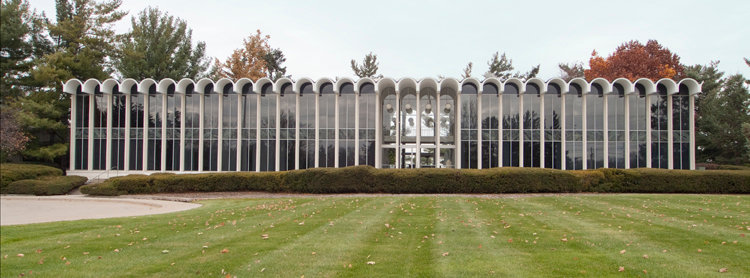
Liebermann’s
113 S. Washington Square, Lansing Architect: George Nelson From furniture to graphic design and architecture, George Nelson was one of the world’s most influential masters of Modern design. But Nelson only designed one retail store: this glassy, classy space in the heart of downtown Lansing’s commercial district. Design-conscious Lansing retail queen Betty Price commissioned Nelson to build the store in 1964. Set back from the other storefronts, the store looks at the world through 22-foot-high windows suspended on a steel frame, with sidewalls of jade green and multicolored slate that flow out of the interior. Liebermann’s downtown store closed in 1991, but the empty space retains much of the original design.

Lansing City Hall 124 W. Michigan Ave., Lansing Architects: Lee and Kenneth C. Black The sleek, International style of glass and steel office buildings is represented most purely in Lansing by City Hall and Police Headquarters, built in 1956-58.

Michigan State Medical Society 129 W. Saginaw St., East Lansing Architect: Minoru Yamasaki One of Modernism’s leading lights was Troy, Mich.-based Minoru Yamasaki, designer of the World Trade Center in New York and many Michigan buildings. Yamasaki brought the quiet tracery of arches and columns to the stark glass and steel forms of Modernism. The north and south facades of the Medical Society building in East Lansing are ribbed with 32 delicate columns of quartz-aggregate cast concrete. The building was listed on the National Register of Historic Places in 2011.

401 S. Capitol Ave., Lansing Architect: Kenneth Black and Associates If Michigan Modern means anything, it means tempering the glassy expressionlessness of International Modernism with extra texture and even — dare we say it? — homey touches. The 1966 dedication brochure for Lansing’s downtown library describes it as “contemporary but with a traditional warmth and dignity so often lacking in contemporary buildings.” The library is humanized by unique touches like a sunken plaza and Japanese-style garden with trees, rocks and benches. The façade glitters with quartz crystals embedded in decorative panels stamped with the logos of the eight foremost publishers in the United States.

The Goetsch-Winkler House 2410 Hulett Rd. Okemos Architect: Frank Lloyd Wright This 1,350-square-foot house proved too small for its first owners, Alma Goetsch and Kathrine Winckler, artists and art educators at MSU, who built it in 1939-40. It’s listed in the National Register of Historic Places as one of the best surviving examples in of Frank Lloyd Wright’s inexpensive, simple, land-hugging Usonian style.

Merten Insurance Building 935 E. Grand River Ave., East Lansing Architect: Kenneth Black & Associates The flat roofs, wide overhangs and horizontal planes that mark Frank Lloyd Wright’s Prairie style architecture was well suited to modest commercial buildings, especially banks. This clean-lined insurance office is a well-preserved example.

Dawn Donuts (now Bell’s Greek Pizza) 1135 E. Grand River Ave., East Lansing Architect unknown This sugar blast of a building, built in 1963, is the Lansing area’s most spectacular remaining example of Googie architecture. (The wagon-shaped former Arby’s restautant down the street, now a Biggby Coffee, is another.) Exuberant, self-advertising, curiously shaped stores and restaurants popped up along rural roadsides and suburban thoroughfares across America in the 1950s and ‘60s.

Edgewood United Church 469 Hagadorn Rd., East Lansing Architects: Laitala and Nuechterlein Hexagonal on the outside and circular on the inside, the sanctuary at Edgewood United Church gives heavy wood beams a soaring, weightless sense of lift, like an upside down drain sucking earthly cares into the heavens. At the sanctuary’s 1966 dedication, Michigan State University philosophy Professor John Taylor described the space as a “majestic rise in which heaven and earth are joined climactically.”

Wallis M. and Norine Antuck House 3815 Waverly Hills Road, Lansing Architect: William Kessler
One of very few minimalist glass-and-steel houses in the Lansing area, this house follows the exact design of architect William Kessler’s own accordion-roof house in Grosse Pointe Park. After the original house was publicized in the March 1961 Architectural Record, Kessler sold the plans to other clients, including a Lansing couple that built a replica in 1963.
Kessler studied with Walter Gropius and designed many buildings in Detroit, along with the huge Michigan Library and Historical Center in Lansing. “Minds of Modernism,” on display at the Michigan Historical Museum, features some of Kessler’s architectural designs, along with a rare display of his colorful fine art.

Schmidt’s Food Market (now PlayMakers) 2249 W. Grand River Ave., Okemos Architects: Manson, Jackson & Kane The barrel-vaulted “store of tomorrow … today” opened in 1958 to serve the growing suburb of Okemos. Laminated wood arches rise to 16 feet and span 110 feet of open space.
Support City Pulse - Donate Today!
Comments
No comments on this item Please log in to comment by clicking here